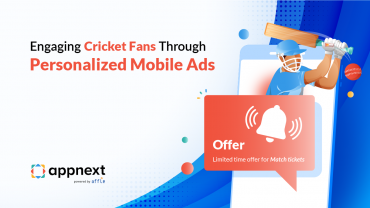Seventy-eight percent of major Russian brands consider re-targeting as the most effective advertising technology. According to a 2017 IAB Russia research report on interactive advertising trends, re-targeting has become the most effective promotion tool among Russian companies. Today, 58% of Russian companies use re-targeting and another 17% plan to use it in 2018.
Reasons to use mobile re-targeting
- Eighty percent of users do not return to the app within 3 months after they have installed it.
- There is a trend towards consolidation. People use fewer applications but the ones they have, the use more frequently. Instead of installing 10 different food applications, they use only one or two.
- The major market players have already taken most of the audience who interested in the product. Further growth could rely mainly on an increasing number of new devices on the market, but it is important to mention that the growth is not as strong these days.
- Acquiring traffic becomes more expensive as the cost-per-install grows and becomes unprofitable. It is much more profitable for companies to work with already existing app users.
Re-targeting, in this turn, is a unique solution to the problems and challenges that the market is facing today.
Expert Opinions
We have gathered opinions from key representatives of some of the largest Russian companies. They share their visions on re-targeting as a tool for promoted mobile apps.
Oleg Dorozhok, Head of Marketing, Delivery Club
Mobile re-targeting is rather a new and an effective way to return users to the app. We see a lot of potential in it. At the moment we spend 5% of marketing expenses on re-targeting campaigns at best, although it should be 20% or more.
Delivery Club is the market leading food delivery company in Russia with over 4000 restaurants in 75 cities.
Maxim Pogrebnyak, Mobile Marketing Manager, OZON
Re-targeting is the most important mechanism for returning users to the application. Attracting newcomers is always more expensive, while most of the money is usually brought by those users who are already loyal to your brand. Companies still tend to invest in user acquisition more, while spending only about 10–20% of their total budget on re-targeting,” says Maxim. “With the technology advancements and the rising level of development the mobile application market, re-targeting is becoming more intelligent. It can now employ predictive mathematical models that calculate the probability that a user will return and correctly distribute rates for different customer categories. In 2018, the personalization will continue to be an important strategy, opening up new opportunities to differentiate approaches to re-targeting.
In 2017, myTarget, an advertising platform developed by Mail.Ru Group working with all major Russian social networks, has taken a big step forward in the development of re-targeting products. The platform has added the support for deep links for iOS and Android devices, improved the share of users who return to the app and implemented the internal traffic statistics feature.
Yakov Peisakhzon, Sales Director at myTarget.
In 2018, we will continue developing our mobile app re-targeting system and optimizing in-app events. We are now testing lookalike audiences and will present the results at the beginning of next year. Also, we plan to implement the ability to handle deferred deep links, allowing the user to open a personalized window upon installation on both mobile platforms, and the ability to incorporate them into a dynamic advertising structure. Comparing the 2016 and 2017 mobile re-targeting campaigns, the following dynamics can be observed: In terms of achieved goals there was a 40 times growth; investments in advertising have increased 13 times; and the CPA has dropped by 67%.
Mobile re-targeting has grown 3.5 times compared to the previous year.
Shani Rosenfelder, Head of Content & Mobile Insights at AppsFlyer
Most app marketers now understand that an install is only a stage in their funnel — an important one nonetheless, but still only a means. The goal is monetization, especially for the vast majority of apps which are free and rely on in-app purchases and in-app advertising to make money. Without ongoing app usage at scale, driving revenue is extremely hard.
Furthermore, algorithms used by app stores are now far more focused on engagement rather than scale. As such, it is no surprise that we’re seeing a 3.5 growth in mobile and especially app re-targeting if compared year-over-year. Thanks to improvements in the deep linking technology, apps are now able to show personalized ads and bring users to specific landing pages within an app which is crucial to the effectiveness of this tactic.
Key Trends for the Future of Mobile Re-targeting
Now, let’s have a look at key trends that will shape the future for mobile re-targeting in the coming year.
1. User segmentation
Today, the majority of advertising platforms allow you to quickly and easily work with the audience. You can upload the desired audience segments and target specific users. For example, in 2017, two platforms, Appsflyer and Adjust, have launched Audience Builder, a tool that allows you to build a custom target audience using your own data and then sync the audience with your preferred ad network. Its built-in trackers allow you to configure segments for different in-app events and time slots in a seamless way. re-targeting based on in-app events makes your ads more accurate and increases the conversion rate.
- Appsflyer’s Audiences feature provides a functional solution for user segmentation. You can create audiences based on any app events registered by AppsFlyer using various filters. For example, you can segment the users who have added products to their cart but did not purchase them or those who have installed the app during a certain period but did not begin using it, etc.
- Another tracking platform that allows you to effectively work with dynamic audience segments is Adjust Audience Builder. When creating audiences in it, you can define various targeting conditions such as advertising ID, push token, device type, country, date of installation, last-click attribution, event, etc. Additionally, you can apply various conditions such as include, exclude, less than, fewer than, more than, etc.
Leonid Eletskikh, Head of Sales for Russia and Eastern Europe at Adjust
Audience Builder was launched in March 2017 to capture the personalization trend. By using dynamic audiences, our customers are able to maximize their ROAS and improve their retention metrics. For example, the Runtastic case study shows that in just one month of using Audience Builder, the app’s ROAS has improved by 179.1%. Also, the average spend can be increased by using segmented re-targeting and push notifications. This can be achieved by interacting with the user in a more effective manner, which leads to optimized conversion rates in the long run.
2. Re-engagement
TUNE is another platform developed for making the most out of the mobile advertising with in-app re-targeting. Its Re-Engagement Cohort Report feature, which was launched in 2017, allows you to compare and analyze different re-targeting sources based on cohorts. For instance, in the e-commerce segment, the CPO for the existing users is 3 to 7 times lower than for the new ones.
Such solutions as TUNE’s Re-Engagement Cohort Report make the analysis of re-targeting campaigns simpler, which is very important for the further development of this technique.
3. Measurement and effectiveness
Deep analytics and measurement of effectiveness are among the key trends shaping the re-targeting industry. An increasing number of companies will try to set the right KPIs for their re-targeting campaigns and measure them accurately. Two notions, A/B testing and incrementality, will become ubiquitous. In order to understand how re-targeting can help improve your reach, you will need to run tests and analyze how that affects the growth.
In this example, the users are divided into two groups with only Group A being re-targeted. After a period of time, the CAC (customer acquisition cost) and ROI (return on investment) are compared for each group. If Group A has a better ROI, re-targeting makes sense.
4. Deep linking
In the coming year, the deep linking technology, used to connect web-based and mobile applications, will become easier to configure and much more reliable. It will also become possible to measure the clickability of each link. Yandex’s AppMetrica app, for example, can already track how many pages a user has visited by following a deep link. This allows you to measure the effectiveness of your banner campaign.
Mobile re-targeting is the next step in the evolution of mobile marketing. In 2018, more and more mobile-first companies will be looking towards re-targeting and launching test campaigns. The systems and procedures associated with re-targeting are becoming more advanced each day. Personalization will further evolve giving users a better user experience and producing a many-fold increase in ROI for companies.




Comments are closed.